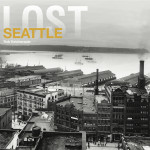Quiet roadways are demanded by wealthy lake-view landowners in this PI article today. The noise abatement laws are new to me - another item to research. [Here's the results of that research]. I wonder what the threshold currently is in downtown?
This is part of the special feature Freeway Box, showcasing my old life next to freeway viaducts.
"Quiet pavement" for I-90 worth a listen, Eastsiders argue
By Natalie Singer
Seattle Times Eastside bureau
E-mail this article
Print this article
Search archive
Most read articles
Most e-mailed articles
A group of Eastside residents hoping to bring noise-reducing rubberized pavement to Washington is trying to force Sound Transit to study the technology for the Interstate 90 bridge.
In a legal proceeding this week, they argued that the rubberized asphalt, which has been used in Arizona and other regions, helps reduce highway noise in nearby communities and often wears better than traditional surfaces.
But Sound Transit lawyers and a state transportation official said studying rubberized asphalt is not required by state or federal law, and that the material wouldn't hold up under Washington's studded tires.
A hearing examiner has until Oct. 25 to decide whether to require Sound Transit to include a study of the "quiet pavement" for its project to reconfigure the bridge lanes.
"All we're asking Sound Transit to do is study the technology," said Walter Scott, a Bellevue resident who argued for the rubberized asphalt without a lawyer Tuesday.
He and about 240 residents from Bellevue, Mercer Island and Beaux Arts are appealing the final environmental study for the bridge project. They live near the bridge and can hear the rush of traffic from their homes and yards; some think the noise has been growing louder.
The residents are angry that quiet pavement wasn't evaluated in the 600-page document.
The $128 million bridge project will add two new car-pool lanes to the bridge by narrowing other lanes. There will be some repaving during the project, but not along the entire span.
Rubberized asphalt is a combination of hot paving asphalt and 15 to 20 percent recycled rubber-tire particles. Arizona began using the material on a test basis in the late 1960s, at first because it was found to stretch more and wear better than regular asphalt, according to testimony Tuesday by George Way, who was the chief pavement design engineer for Arizona highways for 17 years before he retired several months ago.
Soon, he said, residents in the rapidly growing Phoenix metropolitan area noticed that highway noise seemed more muted with the asphalt rubber. Local representatives pushed for more "quiet pavement," and last year, Arizona adopted the "Quiet Pavements Program" to overlay most of the Phoenix-area freeway system ? 115 miles ? with rubberized asphalt.
The material has also been used in the higher, snowy altitudes in the northern part of that state as well as in California, Texas, Canada, Belgium and a handful of other European countries.
On average, the quiet pavement can reduce noise levels by four decibels, according to Way, who works as a private consultant for a rubberized-asphalt trade association. Ten decibels is the difference between the sound of normal conversation and busy traffic, or between an average factory and Niagara Falls, according to the environmental study on the I-90 project.
The technology also offers an environmental benefit: tire recycling. In Arizona, for example, paving one mile of highway uses about 1,000 tires per lane, Way said. Though it costs more by weight than regular asphalt, a thinner layer of it is needed.
During Tuesday's appeal, lawyers for Sound Transit and the state Department of Transportation tried to show that a study of rubberized asphalt for I-90 was not necessary.
Andrea Tull, the project manager for Sound Transit, said the I-90 lane project would only cause a one- to two-decibel noise increase in some locations, "not perceptible to humans."
Sound on the bridge is measured by receptors. The I-90 study, which measured traffic noise at 38 locations along the road, predicts that in 2005 six of those locations (three in Leschi, one on Mercer Island, one in Bellevue and one on the pedestrian and bicycle path) will exceed the federal limit of 67 decibels for residences and parks. Several more will be almost at the limit.
Common ways of reducing highway noise are with walls or other barriers, which must reduce noise by at least seven decibels to be warranted. Adding walls in Beacon Hill, Mercer Island and Bellevue would provide that much noise reduction, the study found.
But walls must also be within the state's per-household spending allotment for noise abatement ? around $15,000 to $25,000 per house in most cases. In every location where new barriers could significantly cut down noise, the study showed they were too expensive, and they are not recommended.
Tuesday, Tull said one of the reasons that rubberized pavement wasn't studied more closely is that the Federal Highway Administration does not recognize it as an approved noise-reducing measure.
Though it didn't include it in the formal environmental review, Sound Transit has agreed to consider rubberized pavement during the project's final design. However, residents say the technology deserves full environmental review and won't have a fair chance if left to the final design stage.
